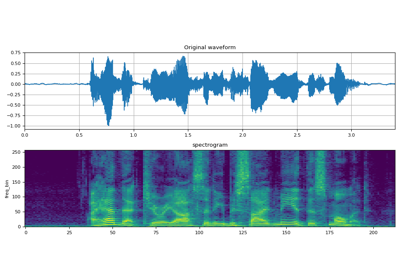LFCC¶
- class torchaudio.transforms.LFCC(sample_rate: int = 16000, n_filter: int = 128, f_min: float = 0.0, f_max: Optional[float] = None, n_lfcc: int = 40, dct_type: int = 2, norm: str = 'ortho', log_lf: bool = False, speckwargs: Optional[dict] = None)[source]¶
從音訊訊號建立線性頻率倒譜系數。
預設情況下,此函式在 DB 縮放的線性濾波聲譜圖上計算 LFCC。這並非教科書式的實現,但此處如此實現是為了與 librosa 保持一致。
此輸出取決於輸入聲譜圖中的最大值,因此對於分割成片段的音訊片段和完整的音訊片段可能會返回不同的值。
- 引數:
sample_rate (int, 可選) – 音訊訊號的取樣率。(預設值:
16000)n_filter (int, 可選) – 應用的線性濾波器數量。(預設值:
128)n_lfcc (int, 可選) – 保留的 LFCC 係數數量。(預設值:
40)f_min (float, 可選) – 最小頻率。(預設值:
0.)f_max (float 或 None, 可選) – 最大頻率。(預設值:
None)dct_type (int, 可選) – 要使用的 DCT(離散餘弦變換)型別。(預設值:
2)norm (str, 可選) – 要使用的範數。(預設值:
"ortho")log_lf (bool, 可選) – 是否使用對數-LF 聲譜圖而不是 DB 縮放的聲譜圖。(預設值:
False)speckwargs (dict 或 None, 可選) – Spectrogram 的引數。(預設值:
None)
- 示例
>>> waveform, sample_rate = torchaudio.load("test.wav", normalize=True) >>> transform = transforms.LFCC( >>> sample_rate=sample_rate, >>> n_lfcc=13, >>> speckwargs={"n_fft": 400, "hop_length": 160, "center": False}, >>> ) >>> lfcc = transform(waveform)
另請參閱
torchaudio.functional.linear_fbanks()- 用於生成濾波器組的函式。- 使用
LFCC的教程

